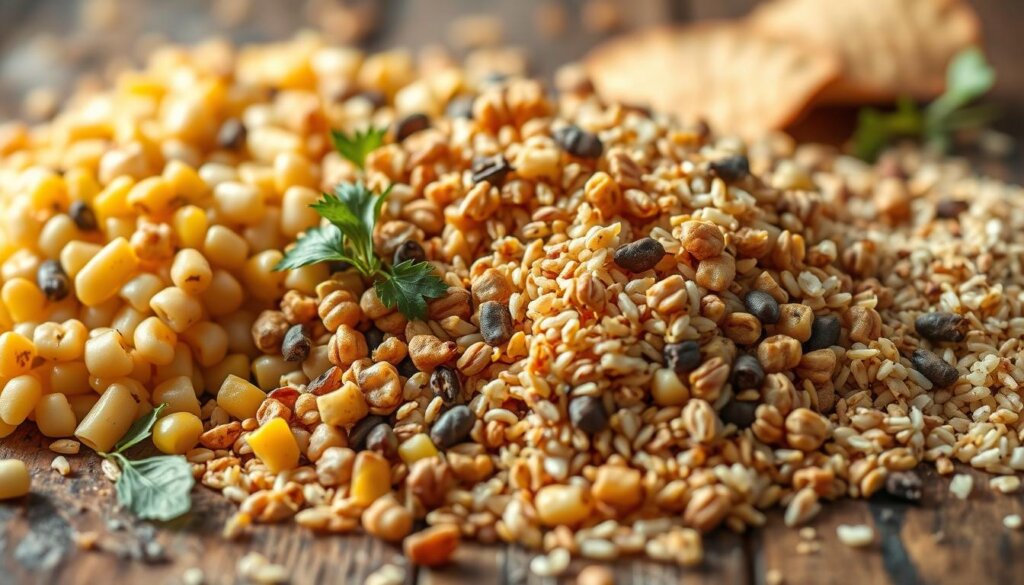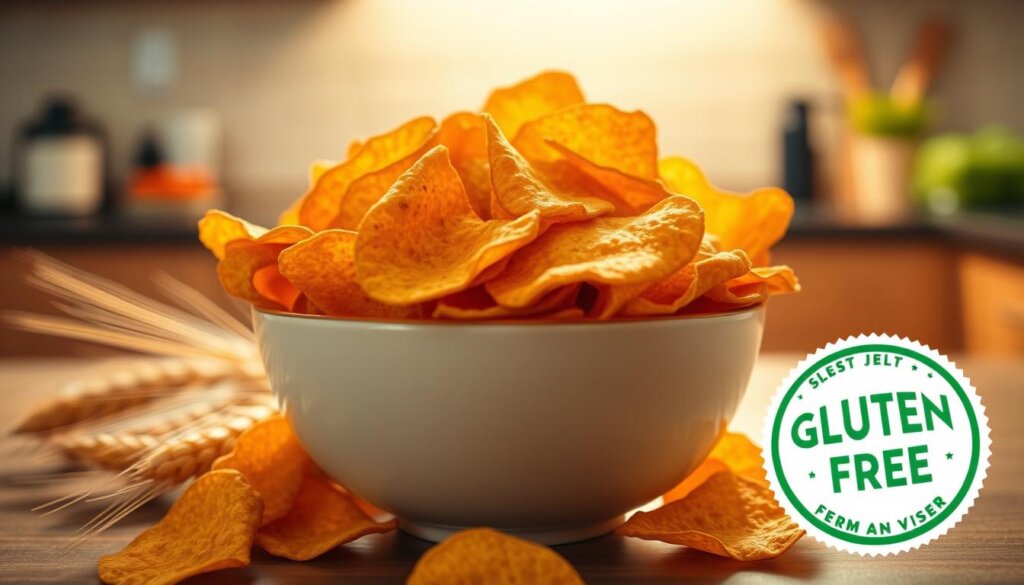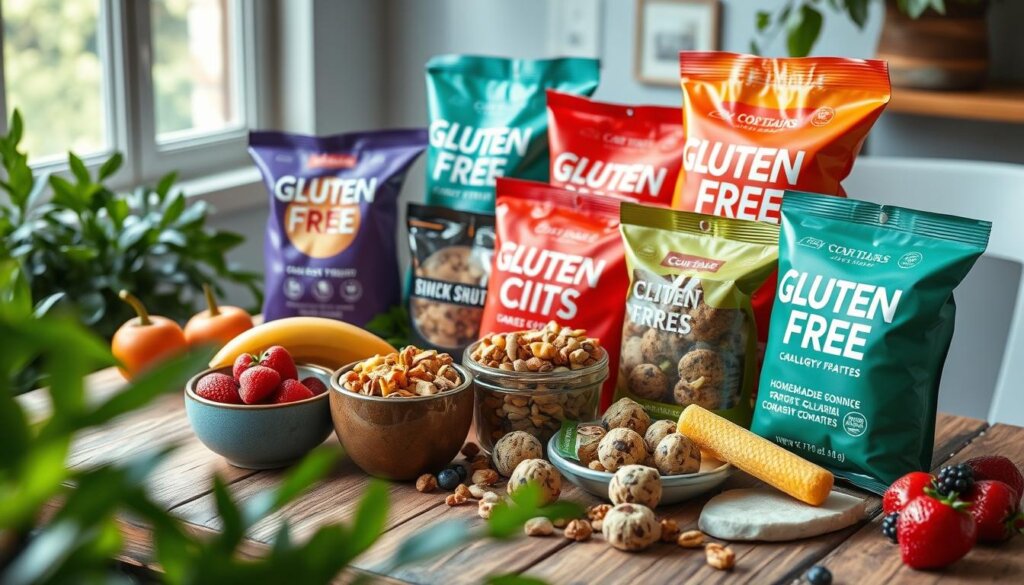Have you ever wondered if that crunchy bag of Sun Chips you love could be harmful rather than satisfying if you have gluten sensitivity? Sun Chips are famous for their bold flavors and satisfying texture, but their gluten-free status isn’t guaranteed. Understanding the ingredients is key for those managing gluten sensitivities.
If you’re exploring gluten-free snacks, consider our Smiley Gluten-Free Potatoes for a fun, safe alternative. For a satisfying crunch, try Gluten-Free Pita Chips or dive into Chips Safe for Celiac Disease to make snack time worry-free!
Table of contents
Introduction to Sun Chips
Sun Chips, a favorite snack from Frito-Lay, have been loved for over 30 years. They are made with a special mix of grains. This makes them stand out with a unique wavy texture and crunch.
People love Sun Chips for their health benefits. They have about 140 calories per serving, which is less than regular potato chips. They also have a good amount of fats and proteins.
Whole grains are the base of Sun Chips. They use corn, wheat, oat flour, and rice flour. Eating whole grains can help lower heart disease and diabetes risks. This makes Sun Chips a great choice, like with Subway meals.
In 2010, Sun Chips started using compostable bags. But, they changed them after people complained about the noise. This shows they care about health and the environment.
Many fans love Sun Chips’ different flavors. They are a healthy snack option. But, they have wheat, so they’re not good for those with gluten issues. Knowing Sun Chips’ history helps us see why they’re special in the snack world.
What Ingredients Are in Sun Chips?
Learning about the Sun Chips ingredients shows how they get their special taste. Sun Chips started in 1991. They have won fans with their unique flavors and textures. The main ingredients are:
Breakdown of Key Ingredients
Sun Chips have many ingredients, with whole grains being key. Let’s take a closer look at the main parts:
| Ingredient | Type | Purpose |
|---|---|---|
| Whole Corn | Whole Grain | Provides flavor and crunch |
| Whole Wheat | Whole Grain | Contributes to texture and nutrition |
| Brown Rice Flour | Whole Grain | Enhances the crispiness |
| Whole Oat Flour | Whole Grain | Balances flavor and provides nutrients |
| Sunflower and/or Canola Oil | Fat | Adds richness and aids in frying |
| Sugar | Sweetener | Enhances flavor |
| Salt | Seasoning | Improves taste |
| Natural Flavor | Additive | Boosts overall flavor profile |
| Maltodextrin | Thickener | Enhances texture |
Whole Grains and Their Benefits
Whole grains are a big part of Sun Chips ingredients. They are key for many health benefits. Eating whole grains can help your digestion, heart health, and nutrient intake.
- Improved digestive health
- Better heart health
- Increased intake of essential nutrients
Snacks like Sun Chips with whole grains are good for a balanced diet. They also satisfy your cravings.

Understanding Gluten and Its Effects
Learning about gluten’s role in food and its health effects is key. Many eat gluten without knowing it. Gluten is in wheat, barley, and rye, making many baked goods. But, for some, gluten can cause health problems.
What is Gluten?
Gluten is a protein that makes dough stretchy and chewy. It’s common in many foods. But, it’s bad for some people, causing stomach pain and other issues.
Health Implications of Gluten Consumption
For those with celiac disease, gluten is very dangerous. About 1 in 133 Americans have it. But, 83% of them don’t know they have it.
Symptoms include bloating, stomach pain, and feeling very tired. Long-term, it can lead to weak bones and trouble getting pregnant. Even without celiac disease, some people choose gluten-free foods. But, there’s no strong science backing up these choices.
| Health Risks of Gluten | Individuals Affected | Potential Symptoms |
|---|---|---|
| Celiac Disease | 1 in 133 (1% of population) | Bloating, abdominal pain, fatigue |
| Gluten Sensitivity | Varies (not well-defined) | Fatigue, headaches, digestive issues |
| Undiagnosed Celiac Disease | About 83% of affected individuals | Osteoporosis, anemia, infertility |
Are Sun Chips Gluten Free?
When thinking about Sun Chips and gluten-free diets, it’s key to look at their ingredients and how they’re made. Some parts of Sun Chips make people wonder if they’re safe for those who can’t eat gluten.
Examining the Ingredients
Sun Chips have whole corn, sunflower and/or canola oil, and whole wheat. They also have brown rice flour, whole oat flour, sugar, salt, natural flavor, and maltodextrin from corn. The whole wheat means Sun Chips have gluten, so they’re not gluten-free. All flavors, like Original and Harvest Cheddar, have this gluten.
So, knowing about Sun Chips’ gluten content is very important for those with gluten issues or celiac disease.
Potential Cross-Contamination Risks
Frito-Lay tries to avoid gluten cross-contamination when making Sun Chips. They use separate lines and clean well. But, some gluten might get in, even with careful steps.
So, even with a gluten-free label, people should be careful. Getting gluten-free certification is key for those who must avoid gluten.

| Ingredient | Gluten Presence |
|---|---|
| Whole Corn | No |
| Whole Wheat | Yes |
| Brown Rice Flour | No |
| Whole Oat Flour | Potentially (may be processed with gluten) |
| Maltodextrin (from corn) | No |
Manufacturing Practices of Sun Chips
The Sun Chips manufacturing process focuses on keeping consumers safe, including those with gluten sensitivities. Frito-Lay has strict rules to keep gluten out of Sun Chips. This makes sure the product is safe and builds trust with customers.
Production Protocols to Prevent Gluten Contamination
Frito-Lay uses special lines for gluten-free snacks. These lines are cleaned well before and after use. This stops gluten from getting into the snacks.
They also check these rules often. This makes sure Sun Chips are safe for those who can’t have gluten. It’s part of a big change in the food world for gluten-free foods.
Importance of Gluten-Free Certification
Getting gluten-free certification is key for brands. It shows they care about their gluten-free products. Groups like GFCO check these products to make sure they’re safe.
Sun Chips show they’re gluten-free on their packaging. This makes it easy for people to know they’re safe. Choosing products with this label helps people eat safely.
| Aspects | Details |
|---|---|
| Separate Production Lines | Dedicated lines prevent gluten cross-contamination. |
| Cleaning Protocols | Thorough cleaning between production runs to eliminate risks. |
| Certification | Products are certified by recognized organizations like GFCO. |
| Compliance Audits | Regular inspections to ensure adherence to protocols. |
| Consumer Assurance | Clear labeling for easy identification of gluten-free products. |
Knowing how Sun Chips are made helps you make better choices. If you want more gluten-free snacks, check out gluten-free recipes online.
Alternative Snack Options for Gluten-Free Diets
Following a gluten-free diet can be tough. But, there are many gluten-free snacks out there. They come in different tastes and are easy to find.
Suggestions for Gluten-Free Snacks
- Corn Chips – Choose brands that say they are gluten-free. They’re great for dipping.
- Rice Cakes – They’re light and can be topped with nut butter or hummus.
- Popcorn – It’s naturally gluten-free. Just avoid flavored kinds that might have gluten.
- Nut Mixes – A mix of nuts is full of protein and healthy fats. It’s all gluten-free.
- Jicama Sticks – They’re fresh and crunchy. Enjoy them with salsa or guacamole.
- Kale Chips – Baked kale chips are gluten-free and full of nutrients.
- Coconut Chips – They’re sweet and crunchy. They don’t have gluten, making them a fun snack.
Tips for Reading Labels When Shopping
When looking for gluten-free snacks, reading labels is key. Here are some tips to help you:
- Look for Certified Gluten-Free Labels – The FDA says products must have less than 20 ppm of gluten. The Gluten-Free Certification Organization has a stricter rule of 10 ppm. So, pick certified products when you can.
- Watch Out for Common Gluten Sources – Avoid ingredients like wheat, barley, rye, oats, malt vinegar, and wheat starch. Always check the labels for these.
- Check Sodium Content – Many prepackaged foods, like chips, have a lot of sodium. Try to find snacks with less sodium to keep your diet balanced.

Consumer Reactions and Popular Flavor Rankings
Exploring Sun Chips flavors can make snacking better. These chips are loved for being whole grain and having less fat. The top flavors show what people like most in taste, texture, and health.
Popular Flavors of Sun Chips
- Harvest Cheddar: It’s the top choice, mixing strong cheddar with a crunchy bite that many enjoy.
- French Onion: This flavor has a deep onion taste, perfect for those who like strong flavors.
- Garden Salsa: A mix of tomato and spices, it’s a fresh choice to add excitement to your snacks.
- Original: It’s the classic corn chip taste, loved by those who prefer the traditional.
- Sweet Potato: It has a sweet taste, great for those wanting a healthier chip option.
- Multigrain: It’s for those who care about health, blending different whole grains for a good nutritional mix.
Feedback from Gluten-Sensitive Consumers
People with gluten issues share their thoughts on Sun Chips. They like that Sun Chips are 100% whole grain and have no artificial flavors. They enjoy flavors like Harvest Cheddar but look for gluten-free options too.
Some suggest Bare baked chips and Snacklins as good alternatives. Siete Foods’ grain-free tortilla chips and Barnana’s Acapulco lime plantain chips are also praised for taste and texture.
| Flavor | Popularity Ranking | Gluten-Free Feedback |
|---|---|---|
| Harvest Cheddar | 1 | Highly praised for taste and texture |
| French Onion | 2 | Enjoyed by many gluten-sensitive snackers |
| Garden Salsa | 3 | Fresh flavor noted for zesty appeal |
| Original | 4 | Traditionalists appreciate its simple flavor |
| Sweet Potato | 5 | Seen as a healthy alternative |
| Multigrain | 6 | Offers a robust nutritional profile |
Conclusion
Frito-Lay works hard to make Sun Chips gluten-free. This is great for people with gluten issues. Always check the packaging for gluten-free labels.
Even small amounts of gluten can hurt your health. So, it’s key to know what’s in your snacks. This helps you make smart choices.
Even though Sun Chips use whole grains, they might not be completely gluten-free. This is because of possible cross-contamination during making. Always read labels and know the risks.
Choosing the right snacks is vital for your health if you have gluten sensitivities. Stay informed and look for snacks that fit your needs. If unsure, learn more about gluten-free options for safe snacking.
FAQ
Are Sun Chips gluten free?
No, Sun Chips are not gluten-free. They have whole wheat, which has gluten. People with gluten issues should not eat them.
What are the main ingredients in Sun Chips?
Sun Chips have whole corn, whole wheat, brown rice flour, and whole oat flour. They also have sugar, salt, natural flavor, and maltodextrin.
What health risks are associated with gluten consumption?
Eating gluten can harm those with gluten intolerance or celiac disease. Symptoms include bloating, stomach pain, and feeling tired.
What is cross-contamination, and how does it affect Sun Chips?
Cross-contamination happens when gluten-free and gluten products are made together. This is a big risk for those with gluten issues. It’s important to look for gluten-free labels.
How does Frito-Lay ensure gluten-free safety during manufacturing?
Frito-Lay uses strict rules to avoid gluten contamination. They make gluten-free products on separate lines and clean a lot.
What are some gluten-free alternatives to Sun Chips?
Good gluten-free snacks include corn chips, rice cakes, popcorn, and nut mixes. Always check the labels to make sure they are gluten-free.
How can I read labels to identify gluten-free products?
Look for certified gluten-free labels when shopping. Also, know that wheat, barley, and rye have gluten. This helps avoid health problems.
What are the most popular flavors of Sun Chips among consumers?
People love Original, Harvest Cheddar, and French Onion flavors. But, those with gluten issues might look for other snacks.
Can gluten sensitivity develop later in life?
Yes, gluten sensitivity can start at any age. It might come on suddenly or slowly. It’s important to watch for symptoms.





